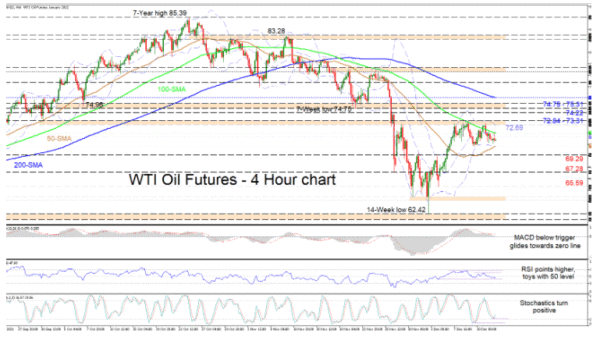WTI oil futures are consolidating between the squeezed Bollinger bands at 70.35 and 72.69 after failing to surpass the 73.00 hurdle in the previous trading sessions. The longer-term simple moving averages (SMAs) are defending the descent from the 7-year high of 85.39, while the 50-period SMA is suggesting that the recent rally from the 14-week low of 62.42 may still have some power.
The short-term oscillators are indicating that momentum is weak and are transmitting uncorrelated signals in directional momentum. The MACD is slightly beneath its red trigger line and is approaching its zero threshold, while the rising RSI is trying to improve into the bullish territory. The positively charged stochastic oscillator is promoting upside price action in the pair.
Nonetheless, the squeeze in the Bollinger bands is hinting that a surge in volatility is expected, which suggests a larger directional move may unfold.
Immediate hindrance to price advances could emanate from the mid-Bollinger band at 71.44 and the nearby 100-period SMA at 71.85. Slightly higher, the upper Bollinger band coupled with the 72.84-73.31 resistance boundary could cap the recent rally from extending further. However, if buying interest increases, the bulls may stumble around the 74.22 region before challenging the 74.75-75.31 resistance border.
Alternatively, if selling interest intensifies, initial support could stem from the 50-period SMA at 70.35. If the price drops beneath the lower Bollinger band, the price could stall around the 69.29 border before testing the 67.28 low. If negative pressures bolster, the price may then target the December 3 trough of 65.59.
Summarizing, WTI oil futures are currently consolidating and a near-term direction may evolve with a break above the 72.84-73.31 resistance or with a break below the 50-period SMA at 70.35.














